Intel launches 10th-gen ‘Ice Lake’ chips, pushing hard on graphics for notebook PCs - peterscoularl
Intel's eleven new Ice-skating rink Lake chips are betting big on graphics. Intel claims that its new 10th-gen Congress of Racial Equality family, launched Thursday, will offer the best integrated graphics receive of any thin-and-light notebook PC—about equaling what some discrete chips offer in PCWorld tests.
Intel began scene functioning Ice Lake expectations in May, positioning its primary bulk-grocery store 10nm parts as improvements for the notebook PC as a whole, including AI, communications, and I/O. The overarching message is "new:" a new process engineering, a recently CPU core, and a early graphics railway locomotive, along with "newborn" advancements in communications and I/O.
Here are Intel's mobile Ice Lake chips, in a nutshell: 11 processors, most sporting 4 cores and 8 threads, in either a 9W, 15W, or 28W power tier. Base frequencies begin at 700MHz and climb to 2.3GHz, patc single-clock turbo frequencies top out at 4.1GHz. Art frequencies will hover right around 1GHz, with 32, 48 and 64 EUs differentiating performance. We also have real number-mankind testing data to manifest how Ice Lake delivers graphic performance on a par with the last grade of discrete GPUs.
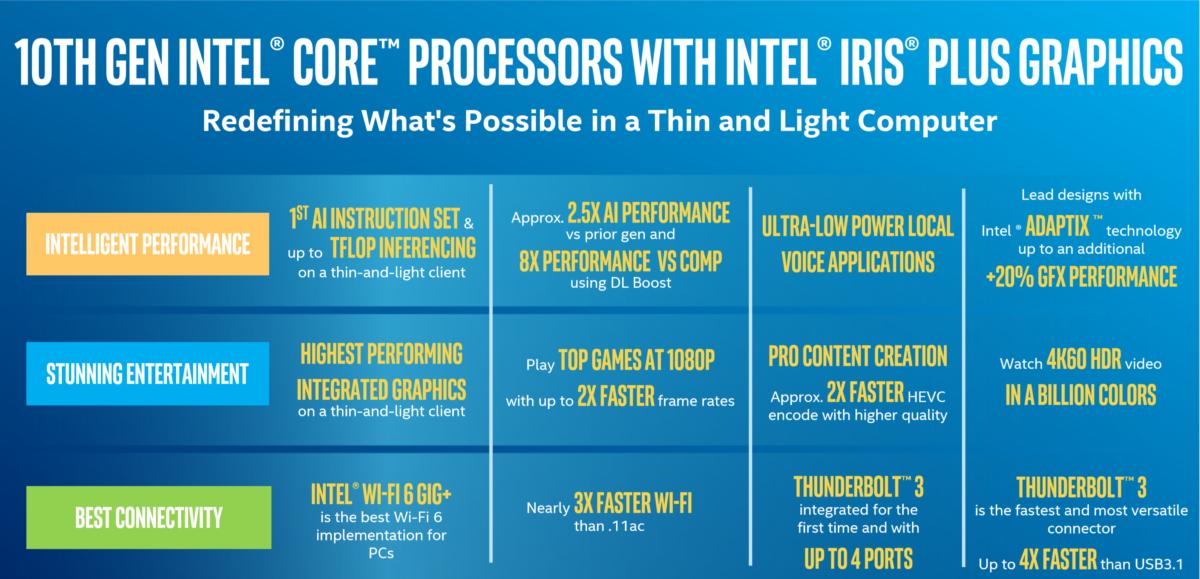 Intel
Intel Ice Lake's "sizzle reel:" everything that Intel believes that Ice rink Lake lavatory offer, on a number of performance axes.
A little of toughie shock, however, Crataegus laevigata affect how some comprehend Ice Lake. Virtually 10th-gen Ice Lake imitative clock speeds come short of their existing 8th-gen Whiskey Lake counterparts. Some of the new Ice Lake Sir David Alexander Cecil Low-exponent chips offer base alfilaria of less than 1GHz. Versions of Ice Lake designed for tablets now consume 9 watts, rather than the 5 watts of their predecessors, Amber Lake.
Intel says that more 35 notebooks reinforced around Ice Lake microprocessors will be sold alongside existing Whiskey Lake and Brownish-yellow Lake notebooks, beginning this vacation season. There's still more to come: Intel'snext microprocessor revelation will be made in the last half of August, where the "second part of our mobile family" will target "high-frequence applications" and form the foundation for Intel's moneymaking offerings, said Ran Senderowitz, vice president of mobile platform marketing for Intel's Client Computing Group.
Will that be Intel's next-gen Panthera tigris Lake chip, due in 2020? Operating theater the Comet Lake chip that was part of a recent leaked roadmap? Things are getting mussy.
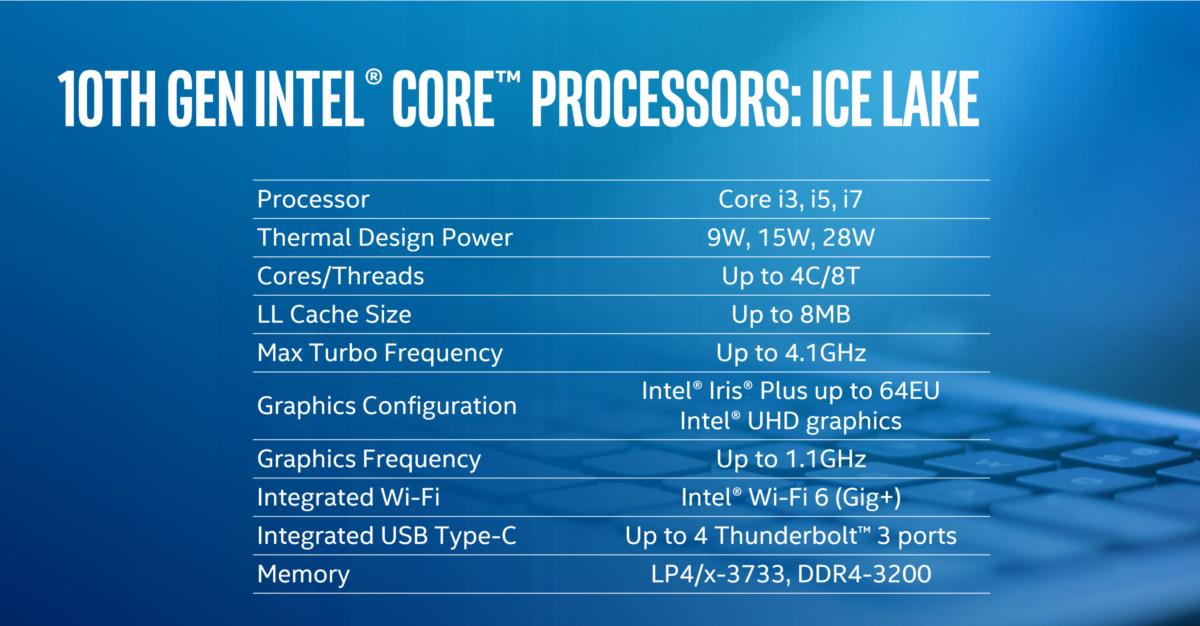 Intel
Intel The basic specifications of Intel's Ice Lake central processing unit, summed up.
How to read Intel's New Ice Lake model numbers
Intel is promising to ship new products to every Microcomputer segment over the side by side 12 months—nothing particularly new, as ware refreshes pass off end-to-end the year. But with a mixture of 14nm and the virgin 10nm products atomic number 27-existing in the market, things may get confusing—specially with Qualcomm's Snapdragon 8cx and AMD's third-gen mobile Ryzen chips also live.
Before you can parse Intel's new Ice Lake products, however, you'll need to describe them—and yes, Intel has a new posture figure scheme, likewise.
Intel still offers Core i3, i5, and i7 central processor families, differentiating their slap-up-better-best status. Apiece Ice Lake model number also begins with a '10' prefix to designate its 10th-generation status.
Now, however, there are good-better-best suffixes, too: the G1, G4, and G7 descriptors signal the various tiers of graphics performance, with both the G4 and G7 tiers falling under the Intel Iris Plus branding. Also, Intel has officially done inaccurate with the U-series and Y-series labels for notebooks and tablets. Instead, the fourth digit of the model number straight off designates the power grade: "5" for a U-series chip, and "0" for a Y-series central processor. A single 28W (or 8-tier up) chip exists: the Core i7-1068G7.
Still confused? We've boiled IT down for you, here:
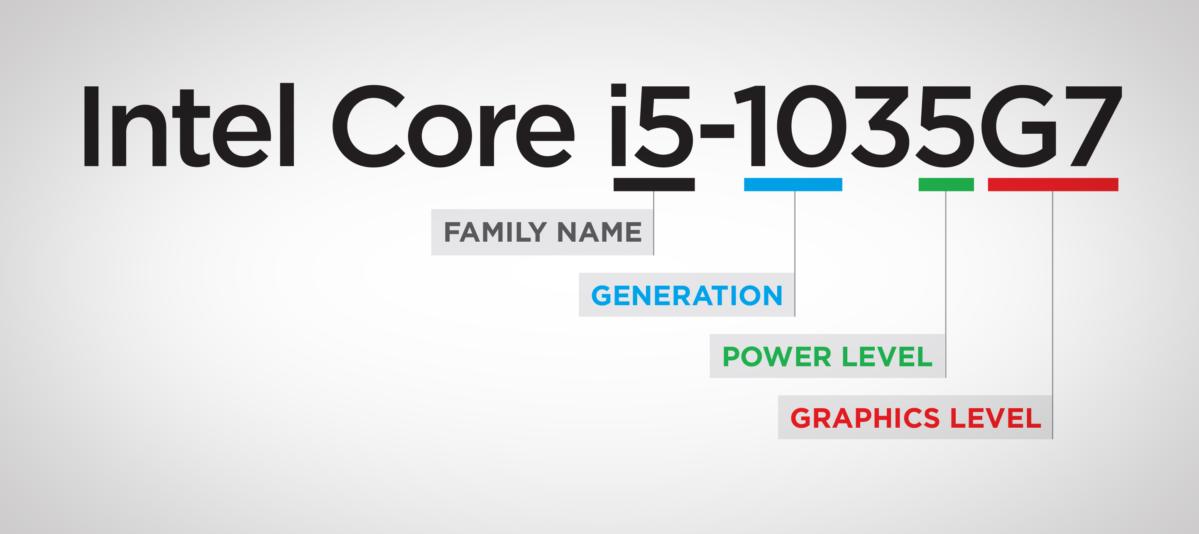 Rob Schultz / IDG
Rob Schultz / IDG Here's how to make sense of the new Intel model numbers.
Intel's eleven Ice Lake chips, explained
Now that you have sex what to look for within Intel's Ice Lake model Book of Numbers, here are the eleven new chips.
Every bit the slide notes, all of the new Ice Lake processors will let in Wi-Fi6 (Gig+) Wi-Fi and Thunderbolt 3 capabilities: four ports this time around, with ii ports available on either side of meat of the Personal computer. We go intofar Sir Thomas More detail in our earlier discussion of the Ice Lake architecture, which is predicated on the Sunny Cove CPU design, a key feature of which is "magic" AI inferencing using Intel's DLBoost instructions.
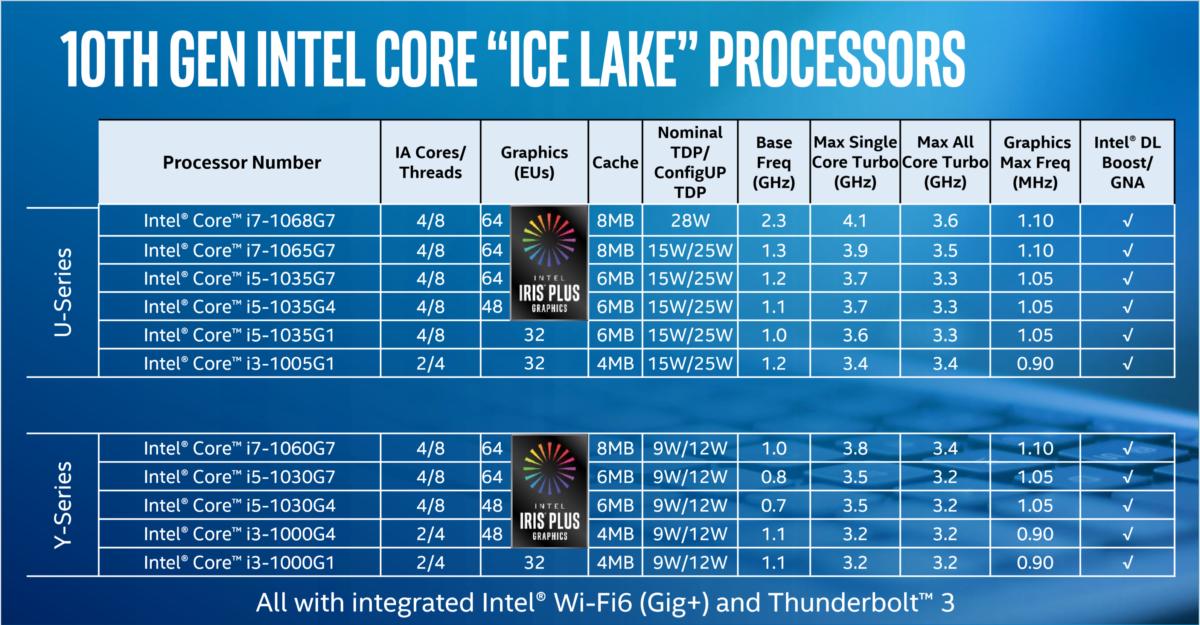 Intel
Intel Intel's cardinal new Ice Lake microprocessors. The ConfigUP TDP numbers show that a laptop maker is permitted to power the chip up to the higher rated electrical power, to enable additional carrying into action. Battery living hindquarters suffer reasonably as a result, however.
We also now know that Intel's Gen11 graphics have ternary different performance tiers, each with different numbers of EUs: 32, 48, and 64. (EUs are Intel's programmable shader units, with 3D rendering, compute, programmable and fixed-routine media capabilities.) Based along what we'ray seeing here, Intel appears to be using the number of EUs as a performance differentiator, preferably than the clock speed. Remember, Intel has previously made the claim that ICE Lake's embedded graphics were as better as what AMD offers, holding pace with the Ryzen 3700U connected a mixed bag of different games.
Accordant to Senderowitz, Intel won't live adding to the three EU graphics tiers (at to the lowest degree for now, we fundament assume). The eleven Ice Lake chips interpret the entireness of Glass Lake products that Intel plans to introduce this year, he said.
Even so, one of our Ice Lake public presentation tests shows how considerably Intel's Ice Lake matches up to the downclocked Nvidia GeForce MX100 discrete GPU that was featured in a recent release of an Huawei Matebook. Intel's claims that its Frosting Lake graphics capabilities close those of a discrete GPU seem to be borne taboo.
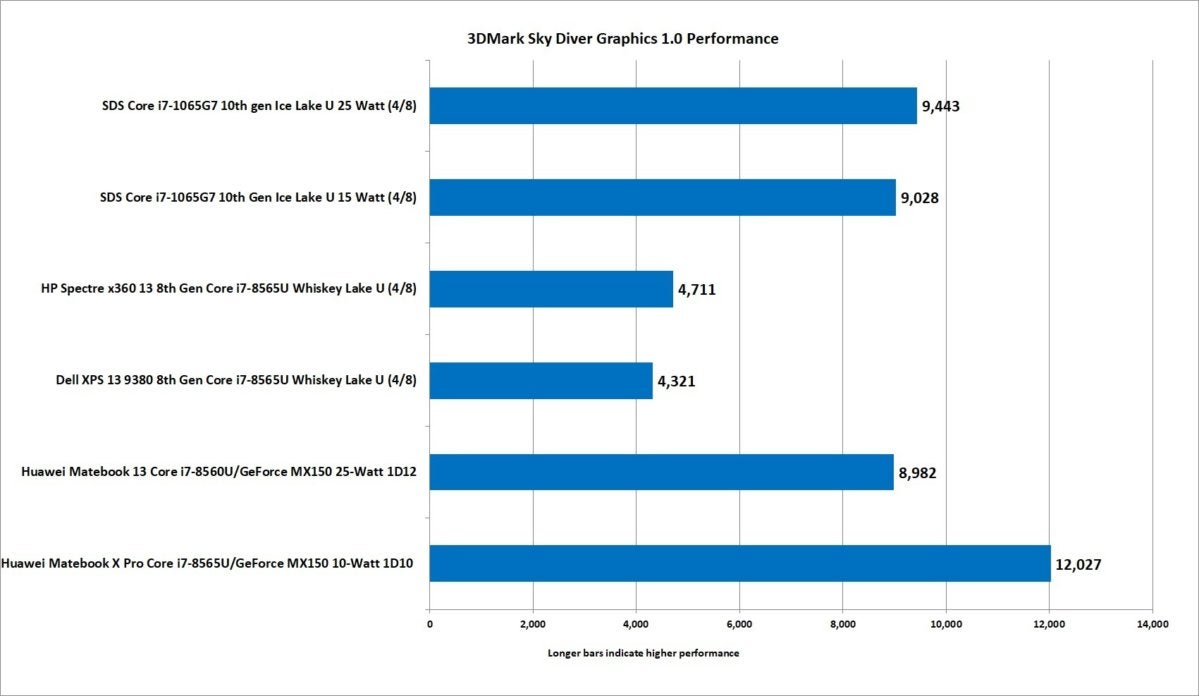 IDG
IDG Note that Huawei used two versions of the GeForce MX100 discrete GPU in successive Matebook notebooks; the slower chip was used in the Huawei Matebook X Affirmative.
While we Don't know what Intel will be charging individual Personal computer makers, Intel promulgated some of its microprocessor prices as part of its ARK database on Thursday morning:
- Core i7-1065G7: $426
- Core i5-1035G7: $320
- Core i5-1035G4: $309
- Core i5-1035G1: $297
- Core i3-1005G1: $281
For reference, Intel's Grand microprocessor price list lists the 8th-gen "Whiskey Lake" i7-8565U at $409, and the Core i5-8265U at $297.
How Ice Lake differs from Whiskey Lake, Amber Lake
What's interesting, though, is that the low-power (previously identified as Y-series) parts use up more power, at 9W, than their 5W Amber Lake predecessors. Ultrabooks and tablets that used the Amber Lake Y-series chips were relatively few—Ultrabook Review counted just seven, of which 5 were 13-inches or larger. It's not authorize whether the high power levels will end up attracting many tablet customers. Save for Dingle's announcement of its Tras Lake-based XPS 13 2-in-1, we really don't know which notebooks leave use Methamphetamine hydrochloride Lake, period.
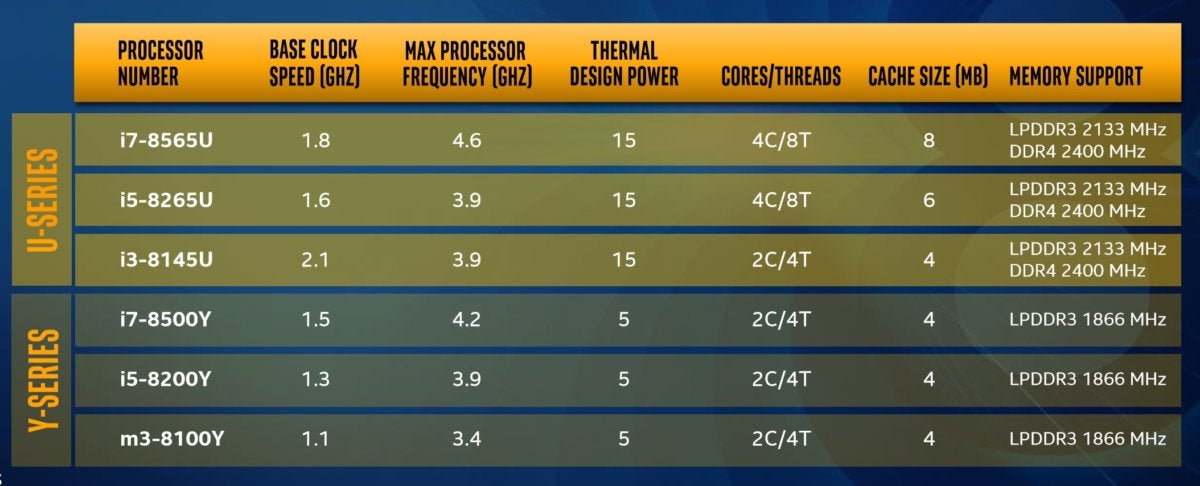 Intel
Intel On paper, Intel's 8th-gen Whiskey Lake chips look more photogenic. But Intel says design enhancements and other improvements will rise veridical-Earth performance high.
The vast majority of Frappe Lake chips also start out at extremely low clock speeds, notwithstandin can boost to about the levels of their Whiskey Lake counterparts. How nightlong Shabu Lake chips give the sack remain in cost increase mode will help determine their carrying into action. Over again, our execution evaluation goes into more detail.
While Intel's eighth-gen Whisky Lake chips still emphasized performance increases versus the prior contemporaries, those chips introduced Intel's gigabit WiF and two ports of Thunderbolt 3 I/O. Both have been beefed up, to gigabit+ speeds as well as four Thunderbolt ports.
Intel too increased its graphics quality as well as its performance, with support for three synchronous 4K displays at 120Hz, a pair of 5K displays at 60Hz, Oregon a single 8K30 display. The nontextual matter engine includes three display pipes that support DisplayPort 1.4 HBR3 and HDMI 2.08, plus HDR10 and Ray M. Dolby Vision.
What's next? Imag Pallas Athen, faster speeds, likely more cores
What we'll learn at the end of August about the adjacent chip leave also help position Ice Lake. Will that break off preface an H-serial part? Simply flesh outgoing the top finish of the "U-series" lineup with a Core i9 offering? Introduce an entirely newborn card? Supported what Senderowitz said most the entirety of the Frappe Lake product line, we'd opt for the latter. Apparently the Core i7-1068G7 doesn't necessarily represent the high cease of Intel's Pith offerings for 2019. A six-core, twelve-thread central processor almost certainly is in Intel's future, excessively.
Retrieve, Ice Lake represents Intel's first mass-securities industry 10nm processorand its premiere major redesign in several generations. Level though Intel shipped its first 10nm Cannon Lake nick, the Meat i3-8121U, in May 2018, it probably never exceeded extremely low volumes. It's fair to say, then, that Intel has significant latitude to refine the 10nm process and push high future clock speeds.
"I think that you will equal able to see how we optimize the workloads…for more segmented and more targeted designs to meet customer needs," Senderowitz said of what you can expect of Intel's futurity CPU positioning.
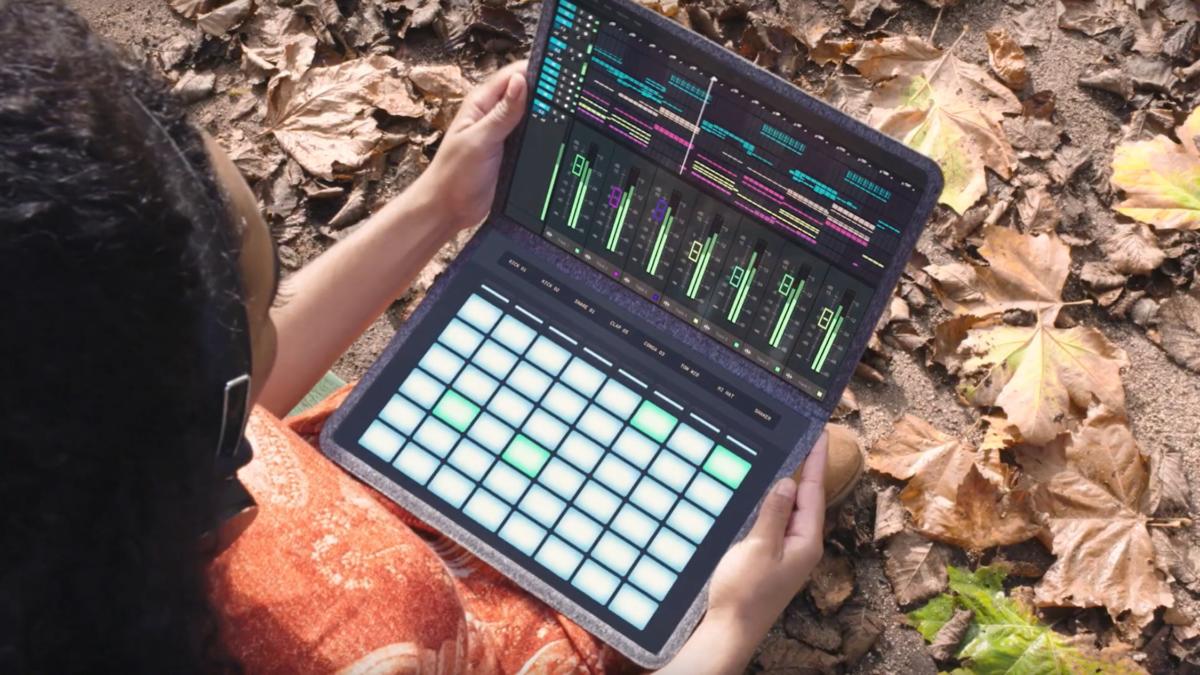 Intel / YouTube
Intel / YouTube We've been waiting for a year operating room so for Protrude Athena concepts and other designs to go far, though they've been designed to puddle a splash when they do.
For now, however, Intel's betting big along Ice Lake, and you should see numerous thin-and-frivolous and notebook designs built around Intel's Ice Lake processors this holiday mollify. Remember, to a fault, that those will include "Project Pallas Athena" designs: garish "halo" notebooks similar to H.P.'s Shade Folio, that try to fulfill bold new things with the close-generation ultrabook form factor.
If you're in the market for a notebook computer PC this holiday season, though, we can already state that you'll benefit immensely from knowing what you're buying. We see 2nd- and a a few 3rd-gen Ryzen notebooks crowding the low end of the notebook PC market, alongside the 7th- and 8th-gen Nub chips that will give way to Ice Lake and its future, quicker, cousins. Qualcomm claims that its Snapdragon 8cx offers Nucleus i5-class performance, besides.
Entirely of that competition can create mental confusion. But you, as a customer, leave ultimately benefit.
This story was updated at 9:37 AM to include Intel's published processor prices for its 10th-gen Core, Ice Lake chips.
Source: https://www.pcworld.com/article/397829/intel-10th-gen-ice-lake-chips-specs-features-pricing-availability.html
Posted by: peterscoularl.blogspot.com


0 Response to "Intel launches 10th-gen ‘Ice Lake’ chips, pushing hard on graphics for notebook PCs - peterscoularl"
Post a Comment